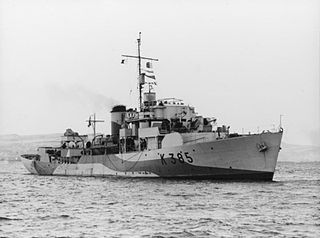
HMAS Echuca (J252/M252), named for the town of Echuca, Victoria, was one of 60 Bathurst-class corvettes constructed during World War II, and one of 36 initially manned and commissioned by the Royal Australian Navy (RAN).
HMAS Hawk was a Ton-class minesweeper operated by the Royal Navy and the Royal Australian Navy (RAN). The minesweeper was built for the Royal Navy as HMS Gamston, but renamed HMS Somerlyton before entering service. She was sold to Australia in 1961, and commissioned as HMAS Hawk in 1962. The ship operated through the Indonesia-Malaysia Confrontation, and was decommissioned in 1972.

HMAS Inverell, named for the town of Inverell, New South Wales, was one of 60 Bathurst-class corvettes constructed during World War II, and one of 36 initially manned and commissioned solely by the Royal Australian Navy (RAN).

The Royal New Zealand Navy is the maritime arm of the New Zealand Defence Force. The fleet currently consists of nine ships. The Navy had its origins in the Naval Defence Act 1913, and the subsequent purchase of the cruiser HMS Philomel, which by 1921 had been moored in Auckland as a training ship. A slow buildup occurred during the Interwar period, and then perhaps the infant Navy's finest hour occurred soon after the beginning of World War II when HMS Achilles fought alongside two other Royal Navy cruisers at the Battle of the River Plate in December 1939.

HMS Dido was a Royal Navy (RN) Leander-class frigate. Entering service in 1961, Dido was involved in the Indonesia–Malaysia confrontation, served with NATO's Standing Naval Force Atlantic on several occasions, and was one of the frigates used for the filming of the drama series Warship.

HMNZS Resolution (A14) was a hydrographic ship of the Royal New Zealand Navy (RNZN). Originally the United States Naval Ship USNS Tenacious (T-AGOS-17), the Stalwart-class ocean surveillance ship was used by the United States to locate and track Soviet submarines from 1989 to 1997, when she was transferred to the RNZN for use as a hydrographic survey ship. She served until 27 April 2012. She was subsequently sold to EGS Group, a private surveying company, and renamed RV Geo Resolution.

HMNZS Wellington was a Leander-class frigate of the Royal Navy and the Royal New Zealand Navy (RNZN). Originally commissioned in 1969 for the Royal Navy as HMS Bacchante, she joined the RNZN in 1982. She was decommissioned in 1999 and sunk in 2005.
Two ships of the Royal New Zealand Navy (RNZN) have been named HMNZS Wakakura:
The New Zealand armed forces saw action in Malaysia throughout the 1950s and 1960s, first as part of the British Commonwealth response to the Malayan Emergency, and then in defence of Malaysia in the Indonesia–Malaysia confrontation.
HMNZS Waikato (F55) was a Leander Batch 2TA frigate of the Royal New Zealand Navy (RNZN). She was one of two Leanders built for the RNZN, the other being the Batch 3 HMNZS Canterbury. These two New Zealand ships relieved British ships of the Armilla patrol during the Falklands conflict, freeing British ships for deployment.

HMNZS Rotoiti (F625) was a Loch-class frigate of the Royal New Zealand Navy (RNZN), which had formerly served in the British Royal Navy as HMS Loch Katrine at the end of World War II.

HMNZS Hawea (F422), formerly HMS Loch Eck (K422), was one of six Loch-class frigates that served in both the Royal Navy (RN) and the Royal New Zealand Navy (RNZN). The ship was laid down by Smiths Dock on 25 October 1943, launched on 25 April 1943 and commissioned into the Royal Navy as HMS Loch Eck on 7 November 1944.
HMNZS Takapu was a modified Moa class inshore patrol vessel of the Royal New Zealand Navy (RNZN).
HMNZS Taupo was a Lake-class patrol vessel of the Royal New Zealand Navy. Taupo was commissioned in 1975 and decommissioned in 1991, serving for 16 years.

HMNZS Arabis was a modified Flower-class corvette of the Royal New Zealand Navy (RNZN). Built for the British Royal Navy as HMS Arabis, she was transferred to the RNZN on completion. She was commissioned in 1944 and decommissioned in 1948.
Commissioned minesweepers and danlayers of the Royal New Zealand Navy (RNZN) from its formation on 1 October 1941 to the present. The RNZN was created two years into World War II. For coherence this article covers the war years from the start, and thus includes also the New Zealand minesweepers operating from the beginning of the war.
The Royal New Zealand Naval Volunteer Reserve (RNZNVR) is the volunteer reserve force of the Royal New Zealand Navy (RNZN).
HMNZS Santon (M1178) was a Ton-class minesweeper that operated in the Royal Navy, the Royal New Zealand Navy (RNZN), and the Argentine Navy. Built for the Royal Navy by Fleetlands Shipyard of Portsmouth, the minesweeper was launched on 18 August 1955 and commissioned as HMS Santon. She was named after a small village in North Lincolnshire. The minesweeper was commissioned in the RNZN from 1965 to 1966, when she was returned to the United Kingdom. She was later transferred to the Argentine Navy, and operated as ARA Chubut (M3).

HMS Loch Katrine was a Loch-class frigate of the British Royal Navy, built by Henry Robb at Leith, Scotland, and named after Loch Katrine in Scotland. The ship was laid down on 31 December 1943, launched on 21 August 1944, and completed and commissioned in December 1944. The ship served in World War II as a convoy escort in the Atlantic, and afterwards in the Indian Ocean. Decommissioned in May 1946, the ship was sold to New Zealand in 1948, and renamed HMNZS Rotoiti (F625). The ship saw active service during the Korean War, and was finally sold for scrap in 1965.

HMNZS Mako was a Harbour Defence Motor Launch (HDML) of the Royal New Zealand Navy. Commissioned in March 1943, the ship saw service in home waters during World War II. She was built by Madden and Lewis Company in Sausalito, California.










